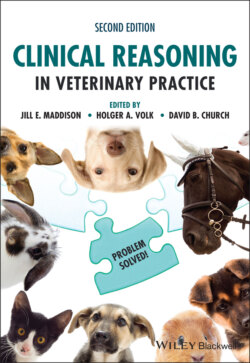Читать книгу Clinical Reasoning in Veterinary Practice - Группа авторов - Страница 38
But does pattern recognition have a place?
ОглавлениеIt is important to reiterate that pattern recognition for many cases is appropriate and justified – depending on your level of experience, knowledge, skill base and mindset. For example, if a pot‐bellied elderly terrier with bilaterally symmetrical alopecia, hyperpigmentation and comedones walked into your consulting room and the owner reported that the dog was drinking lots of water, was ravenously hungry and appeared to be panting excessively, then hyperadrenocorticism is the most obvious diagnosis, and going through the motions of assessing each specific problem would be ridiculous (but not if you had never seen a dog with hyperadrenocorticism before!).
However, it is important to be aware that pattern recognition is only foolproof if:
The pattern is virtually unique to the disease
You consider a sufficient number of factors in your pattern
You carefully evaluate that your pattern does explain all of the clinical problems (and don’t ignore those that don’t)
Or there are a very limited number of diagnostic options.
The value and effectiveness of pattern recognition is very dependent on the clinician’s experience, depth of knowledge, understanding and ability to sort data quickly and efficiently.
Of course, once you have considered each individual problem, you do in fact look for a pattern in the clinical signs. However, the insertion of that initial step of considering each specific problem individually and then relating it to the other problems present should ensure that you don’t miss the less obvious possible diagnoses.
In addition, the process of developing a sound problem‐based approach can enhance your ability to pattern recognise because you have a greater understanding of the reasons why you believe certain patterns are suggestive of some disorders more than others.
